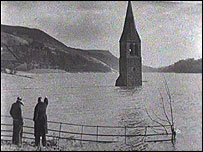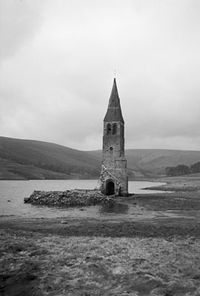
Berlie Doherty’s Deep Secret
I may have said this already but, after this challenge is over, I’d love to explore fiction for children and young adults in more depth because, for the life of me, I can’t work out how to differentiate some of the books from adult fiction. Some of the classifications seem completely arbitrary – is it the writers who categorise themselves or is that the job of the Carnegie Medal judges or editors or publishers…? I want to get to a point where I can encourage adults to read more of this young literature instead of, dare I say, stigmatising it. I do find it hard to believe that a novel as eerie and moving as Deep Secret, by Berlie Doherty, about the flooding of a tiny, beloved village in Derbyshire to make way for a modern dam and reservoir, and about the mature grief felt by young Madeleine after the loss of her twin sister, should be missed out on by the majority of adults simply because it is labelled as ‘too young’ for them.
According to Doherty’s footnote and website, the novel is based loosely on the construction of the Ladybower reservoir between 1935 and 1945, for which the villages of Ashopton and Derwent were submerged. In 1986, Doherty visited the site during a drought which exposed the ruined houses, farm buildings and church below; it was this spine-tingling trip which convinced her to write this story.
Doherty creates a vision of village life that is difficult to fault: there is hierarchy, to be sure, with Lord Henry and his family, who inhabit the Hall estate, owning all the land that the villagers live and farm upon; but they are benevolent masters and looked upon as deeply “romantic” (8) and respectable. The hardworking farmers and their families are “never going to leave the valley” (8) out of choice, but would each choose to “die before they turn […] into a townie” (108) and, despite their status, the Lord and Lady are no more detached from their earth, for “the scents of the flowers and the murmurings of the river, and how peaceful it all is compared with [their] London home” (86) is all they can talk about. The villagers are not hungry for the outside world and want nothing more than “to be running free […] wild and wonderful” (52) in their valley.
It is by their relationship to the land that the villagers define themselves – a trend we have seen in so many novels on this challenge already – but the politics of land ownership itself is more apparent and more emotional here than in any of the others. In the beginning, the villagers are content with their lush farmland “rented from Lord Henry” (6) for their ambitions are small and do not involve the hungry, capitalistic pursuit for their own property; the modern world still seems far away from this small community. Their idea of ownership is simple and unjealous; they work the land that their families have lived on “for donkey’s years” (12) and therefore consider themselves to have more right to it than the workers from the Water Board, who slowly begin making their way into the valley “like an army taking possession by stealth” (78) to complete surveys and then building work. The families try to keep the peace for a time, their protests limited to “frowning Stranger with their eyes” (36) as wagons trundle past, for they have ultimate faith in Lord Henry to protect them.
It is therefore all the more crushing for them to hear Lord Henry himself admit that there is nothing he can do to stop the incomers in their effort to “flood the whole of our valley” (90). In an “Act of Parliament” (92) that is completely incomprehensible to the villagers, whose families have lived contentedly in the traditional, feudal way of life for centuries, the Water Board has “obtained permission from the government” (88) to “purchase this entire estate – the Hall, the farms and cottages that go with it” (92), without so much as an introduction or a handshake. This is business and property ownership in unintelligible terms for the farmers – not only has their powerful Lordship been revealed as impotent in the modern world, but the land itself will no longer be owned by people but by a corporation; it will be “the bloomin’ Water Board’s” (179). How can it be that politicians in London, so far removed from this idyll in Derbyshire, have seen fit to prioritise “a massive container of water” (92) over a whole way of life? This is a dramatic power shift that the villagers are forced to witness. They may not have minded answering to His Lordship, but to suddenly find themselves 150 miles from their new southern masters and treated as completely subaltern is more than they can bear.
Not only are the valley-dwellers forced to come to terms with the fact that power – rather than courtesy – rules the country, but they also see how money rules the world, as when the news arrives that “the Water Board is now selling the Hall to a wealthy American [who] is planning to have it taken down, stone by stone, and to rebuild it elsewhere” (142). Once again, their land is at the mercy of those who have no moral claim to it and, once again, they have to learn how unimportant they are considered in modern society, where “someone with money can just pluck [their way of life] away, just like that, like it was a rosy apple on a tree” (143).
After all, this is a world painted without the concept of good faith, ethics or respectability; the “measuring instruments” (53) the Water Board favour work in units of land area and money, and numbers fly around them “like bubbles in the air, filmy and brilliant, incomprehensible […] in a bubble storm of noughts” (320). Pride is important too, of course, because this valley will be home to “the biggest earth dam in the British Isles”, a “great achievement. A masterpiece […] a symbol of rebirth” (94) and of British arrogance. Behind the propaganda, though, the war may be over but the devastation continues: another “great trench” is forged “like a massive quarry from one end of the valley to the other [and that] reached right into the centre of the earth” (165).
I have to say, it is this aspect of the plot – the fate of the valley and the changing definitions of land ownership – that interests me most and that makes the novel stand out. In contrast, the parts involving characters’ relationships to each other are believable and relatable, but not ground-breaking in their originality. The blind Seth, who becomes Madeleine’s closest friend and confidant, is the most striking persona for me, becoming the valley’s prophet Tiresias. This novel therefore deserves 3/5 stars.

Derwent Church tower, visible above water until demolished in 1947 to prevent people swimming out to it.
However, possibly the saddest thing of all is something I haven’t yet mentioned: how quickly the feudal way of life is forgotten. Within two years everyone, in their brand new homes with electricity and indoor lavatories, is ready to admit that “it just feels as if the lake was always here” (339). Witness the unceremonious death of the past, and the murderers who got away with it, the novel seems to sigh.
Next time I’ll be reading Alan Garner’s Thursbitch for Cheshire. I have a feeling it’s going to be pretty awesome!



